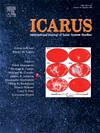Viewing lobate patterns on Mars and Earth as climate modulated fluid-like instabilities
IF 2.5
2区 物理与天体物理
Q2 ASTRONOMY & ASTROPHYSICS
引用次数: 0
Abstract
Lobate features found on high-latitude slopes on Mars resemble terrestrial cold-climate soil patterns known as solifluction lobes. Whether this provides evidence of freeze thaw processes on Mars or pattern equifinality is up for debate. Guided by recently developed theory for solifluction pattern formation inspired by fluid instabilities, here we compare HiRISE imagery of Martian lobes with a large dataset of solifluction lobes on Earth and find that they exhibit similar morphologic scaling. Our data show that Martian lobes are roughly 2.6 times taller than their Earth counterparts, indicative of lobe height set by cohesive soil strength under different gravitational conditions. We also explore possible climate controls on Martian lobe morphology using elevation, aspect, and temperature data. Our work suggests mechanistic similarities between lobate patterns on Earth and Mars that point toward icy origins for these features, with implications for our understanding of climate controls on Martian surface processes.
将火星和地球上的叶状图案视为气候调节的流体状不稳定性
在火星高纬度斜坡上发现的叶状特征类似于地球上寒冷气候的土壤模式,被称为孤裂叶。这是否为火星上的冻融过程提供了证据,还是提供了模式均衡的证据,还有待商榷。在流体不稳定性的启发下,最近发展的波浪模式形成理论的指导下,在这里,我们将火星叶片的HiRISE图像与地球上波浪叶片的大型数据集进行了比较,发现它们表现出相似的形态尺度。我们的数据显示,火星的叶瓣高度大约是地球的2.6倍,这表明在不同的重力条件下,叶瓣高度是由粘性土壤强度决定的。我们还利用海拔、坡向和温度数据探索了可能的气候控制对火星叶片形态的影响。我们的研究表明,地球和火星上的叶状图案在机制上存在相似性,这表明这些特征的起源是冰冷的,这对我们理解火星表面过程的气候控制具有重要意义。
本文章由计算机程序翻译,如有差异,请以英文原文为准。
求助全文
约1分钟内获得全文
求助全文
来源期刊

Icarus
地学天文-天文与天体物理
CiteScore
6.30
自引率
18.80%
发文量
356
审稿时长
2-4 weeks
期刊介绍:
Icarus is devoted to the publication of original contributions in the field of Solar System studies. Manuscripts reporting the results of new research - observational, experimental, or theoretical - concerning the astronomy, geology, meteorology, physics, chemistry, biology, and other scientific aspects of our Solar System or extrasolar systems are welcome. The journal generally does not publish papers devoted exclusively to the Sun, the Earth, celestial mechanics, meteoritics, or astrophysics. Icarus does not publish papers that provide "improved" versions of Bode''s law, or other numerical relations, without a sound physical basis. Icarus does not publish meeting announcements or general notices. Reviews, historical papers, and manuscripts describing spacecraft instrumentation may be considered, but only with prior approval of the editor. An entire issue of the journal is occasionally devoted to a single subject, usually arising from a conference on the same topic. The language of publication is English. American or British usage is accepted, but not a mixture of these.
 求助内容:
求助内容: 应助结果提醒方式:
应助结果提醒方式:


